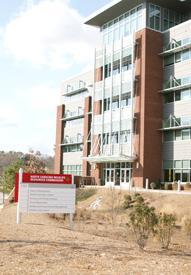Watch out red and white, there’s a new color on campus — Centennial Campus, that is.
At the N.C. Wildlife Resources Commission’s Administrative Headquarters, the favored slice of the color wheel is green — as in green features utilized to save energy and the environment.
“Our new Agency Headquarters and Wildlife Education Center was the first major state government building to be built using sustainable building concepts,” Gordon Myers, deputy director of Operations and Technical services, said.
During its conception, the building’s design team, including College of Design Professor Wayne Place, considered the commission’s commitment to wildlife preservation in its final designs. The University also sought to understand the unique components of the designs, according to Myers.
“The University asked a lot of tough questions when we first proposed this building, and that was good,” Myers said. “It helped for the school to understand us more.”
The “green features” of the building are an integral part of the every aspect of the building, from its landscaping to its placement. There is no grass on the site — instead, mulch and native plants cover the ground. The building is built on an angle, elongating its east-west axis in order to maximize sunlight exposure to the perimeter. There are also plans to add green roofs and water cisterns to catch runoff rainwater.
The 73,000 square foot, six-story structure is anchored at the entrance of Centennial Campus and serves as the home of the N.C. Wildlife Commission, a consolidation of its three offices that served until the headquarters’ completion in October 2005.
“When we determined that we would construct our headquarters, we naturally considered our long-standing relationship with N.C. State, which has included collaboration in the areas of teaching, research and extension,” Myers said.
The move to Centennial Campus was motivated by several factors. Relocating offered opportunities to enhance and expand collaboration with the University, employee recruitment, development of student intern programs and continuing education for its staff, according to Myers, who was part of the team that conceived the building.
The winner of the 2006 Sir Walter Raleigh Award for Community Appearance in the institutional category for its commitment to the environment, the commission is also working on the development of another commitment — education.
Adjacent to North Creek, the building works as an environmental classroom, educating the public about wildlife and conservation of natural resources, Myers said. In addition, it provides an opportunity to experience realistic conservation features that visitors can use in their own homes or offices.
Susannah Thompson, the center’s distance learning coordinator, utilizes the building’s exhibit loop — a collection of displays, interactive stations, craft rooms and an educational theater — to educate local children.
“Our purpose with the exhibits is to help children understand wildlife better in the context of an urban setting, such as Raleigh,” Thompson said. “The exhibit loop will be finished at the end of the month and will include a short video visitors can watch. Our real focus is to incorporate technology with the wildlife aspect that really reflects us as an agency.”
Future plans to reach college students also include fishery management plans for Lake Raleigh that will engage wildlife and fisheries students and include development of a public fishing pier. In addition, there is a lecture series that meets three times a semester led by professors from different colleges within the University — “and there’s free food” Thompson said.








